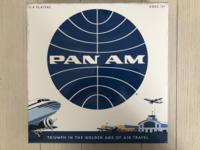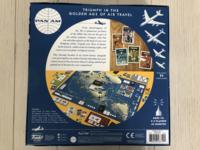Funko Games: Pan Am The Game Review
Posted by: Nick on June 5, 2020 at 01:01 PM CST
We cannot say this enough, Funko Games and Prospero Hall have some amazing new releases this summer with great 3-D components, world building, and fantastic artwork. Once again we were caught off guard by a title that we did not anticipate to be as engaging and fast-paced as you would think from the concept. Thank you to our friends at Funko Games for providing this review sample.
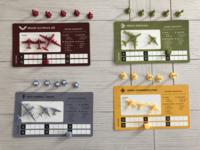
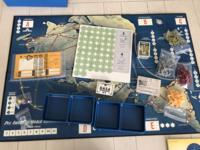
The Concept
Unlike the other upcoming releases we reviewed, there is no traditional movement around a game board with this title. No advancing with a die or action cards. The object is to have as much stock as you can in the rapidly expanding Pan Am airline by the end of the seventh round. You play as one of four small airlines building up you fleet, routes, and presence to get enough money to invest in Pan Am and have the most shares. You get money by growing your company's income with routes and airports or by selling those routes to Pan Am as it expands. This is where the strategy comes in because the expansion path is left up to chance (yes there is still one die in this game).
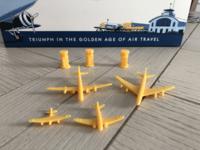

The Contents
The game has a mix of 3-D components and action cards. The 3-D aspects include the planes, airports, engineers (more on that later), and stock price tracker while the cards include events that shape the rounds, destination cards that help you acquire routes, and the secret directive cards that give your airline an edge. There are also chips representing money and the all important Pan Am stock.
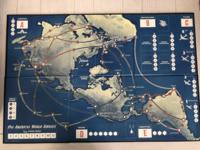
Compared to the other two Funko Games releases we tried (Godzilla: Tokyo Clash and Back to the Future: Back in Time) this game clearly has the most pieces and the largest game board, so anticipate needing a fair amount of room to play with friends.
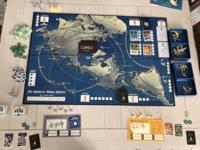
Players are given some starting cash, planes, destination cards, and a mat to track their income and hold their fleet. The instruction manual does a great job of taking you step by step, walking you through setup and play of your first game.
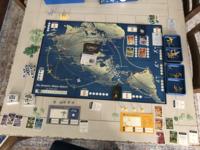
Gameplay
The game lasts for seven rounds of play. Unlike the other aforementioned games, gameplay is more linear and conducted in a very specific pattern and order. Each round is conducted in four phases: an event phase, an engineer phase, a resolution phase, and a Pan Am phase (more on these in a minute). While a lot of this does seem a little daunting and confusing at first, it is really easy to pick up while playing and the rules have multiple examples on different scenarios. We found that everything was thoroughly explained, which is great for any strategy game as so many questions can pop up during play.
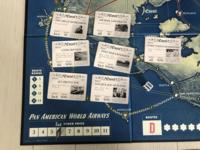
The first phase is called the event phase, and basically an event occurs. Surprise! These events mark historical periods in Pan Am's growth. There is usually a specific action all players must take (receive or lose money, take route cards, get upgrades, etc) and there are some instructions for the end of the round during the Pan Am phase. The last thing you do is adjust the stock marker either raising, lowering, or setting the stock to a specific value. This is a very easy round and should only take seconds.
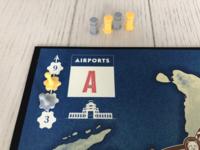
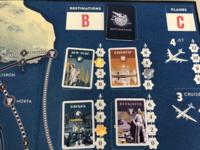
The second phase involves the strategy and provides the competitive part of the game. Each player has a set number of engineers depending on how many players there are in the game. For our purposes, we had two teams, and each team had five engineers. You take turns placing these engineers on the five different action zones to obtain resources including airports, destination cards, routes, planes, and directives. With the exception of routes and directives, the other resources cost money. Further, you can outbid your competitors or they can outbid you, raising the prices on those resources and require you to gamble whether it is worth it at that junction to acquire an airport, plane, or destination card.
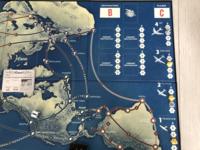
The resolution phase is the meat of the game. Here you must now pay for those airports, planes, and destination cards. The action zones, our words, require you to address them in order A through E. So first you pay for your airport and must immediately place it where you want, the goal is to put it in an area with multiple routes (more on this later). Airports also earn you income, which you'll receive at the end of each round. Then you pay for the destinations needed to obtain the routes and any unobtained routes can build up cash bonuses for subsequent rounds making them a tempting acquisition. Lastly, you pay for your planes, some of which are not accessible until later rounds when technological advances in travel occur over the course of the game. With the exception of the directive part of this phase, engineers return to each player after each of zones, A through E, are completed. Of note, do not bid if you cannot afford it. You will lose all your money and still not be able to get what you are after. You can also sell stock at a loss to acquire funds but since the whole point of the game is to acquire stock, this is a risky move.
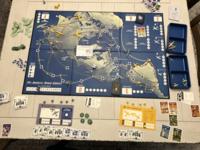
The tricker part of the resolution phase is the route area. This is where you really start to gain money and the ability to build up funds for that stock. To get a route you must have landing rights to both destinations and a plane that can travel the distance. The planes are rated from one to four for distance, planes with three and four are not available until rounds three and six respectively. To get landing rights for a destination you need an airport there, a destination card of that city, a destination card matching the same region of the city that you must discard to get rights for this one instance, or two cards of the same region from a different region you can discard to get rights for this route. Once you have the rights you put the plane on the route and earn income, which is paid to you at the end of each round. The more income, the more money you have to buy stock or invest in the expansion of your airline.
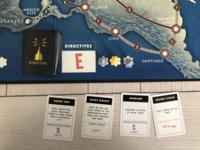
The last part of the resolution phase is really straight forward, you just pick up a directive card. Directive cards give you abilities not shown to other players until you use them. These cards can only be used during the specified phase stated on the card. They can give you more money, free routes, free stock, or additional destinations, among other things. For having your engineer token in one of these spots at the end of the phase you get priority placement of that engineer in the next round before anyone else can go, which can be crucial to helping you secure a coveted destination or plane.
Play now goes to the final phase, the Pan Am phase. Remember the event card from the beginning? Now is time to look at the image on the die and determine if it is one or multiple rolls. You then roll the die the number of times specified, moving Pan Am after each role. The company will expand out of Miami on a determined path as indicated on each roll of the die, buying up the routes as they expand outward. These routes are then not available for players. If your route is on the path as Pan Am expands, then you get paid a bonus for that route depending on the length of the route, there is a key on the side of the game mat for convenience. You then get your plane back and some money but lose that route and the corresponding income on your income mat. The last two actions you take in this round are getting the income you earn from having routes and airports and then buying the Pan Am stock at the price set during the event phase. It is up to you to decide to buy, save your money for expansion, or wait for the price to drop to get more shares later. There is some strategy and a bit of a gamble, but some directive cards can let you peek at the stock price for the next round, helping you figure out your best course of action.
After that the game simply repeats until the seventh and final round. It is easy to keep track of rounds because there are only seven event cards and you use one at the start of each round.

Final Thoughts
This was another title that pleasantly surprised us. We expected the game to be more business oriented and very slow paced, probably aimed at an older crowd, however this is clearly a fast-moving strategy game set in a historical period with plenty of challenge and reply value. Events randomize from game to game and if you want to really mix it up, you can base Pan Am out of another destination instead of Miami to force players to develop a whole new strategy. We definitely think this game is worth a play for any fan of engaging story-based strategy play and historical buffs. Funko Games and Prospero Hall continue to have excellent world building in these games, making you feel like your game pieces are more than pawns but characters in a narrative.
Related Stories:
Funko Games: Last Defense Review
Funko Games: Last Defense Launching Soon

